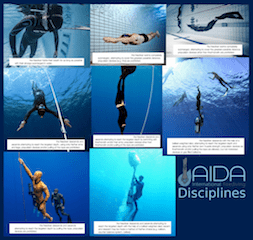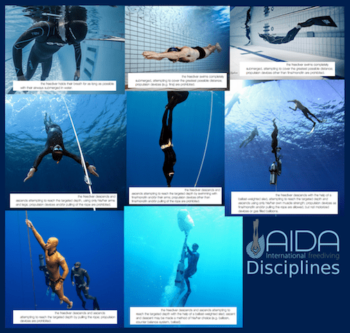Last Updated on May 22, 2025 by Dan
Here are 15 practice questions designed to help students prepare for the PADI Freediver Course exam. These questions cover the key topics such as breath-hold techniques, safety, physiology, and equipment, which are essential for freediving training.
1. What is the primary safety rule when freediving?
a) Always dive with a buddy
b) Never dive deeper than 10 meters
c) Always dive in clear water
d) Dive only during daylight hours
Answer: a) Always dive with a buddy
2. When should you equalize during a freedive?
a) Only when you feel discomfort in your ears
b) At the surface and regularly during descent
c) Once you reach your maximum depth
d) When you start ascending
Answer: b) At the surface and regularly during descent
3. What is the main purpose of a “buddy” in freediving?
a) To carry extra equipment
b) To provide companionship during the dive
c) To monitor the safety of the diver and assist if necessary
d) To dive deeper and faster
Answer: c) To monitor the safety of the diver and assist if necessary
4. What is “shallow water blackout” and when does it typically occur?
a) A loss of consciousness due to hypoxia (low oxygen) after a deep dive
b) A sudden increase in pressure as you ascend from depth
c) A loss of consciousness due to hyperventilation before a dive
d) A temporary loss of vision caused by sunlight at the surface
Answer: a) A loss of consciousness due to hypoxia (low oxygen) after a deep dive
5. How long should a proper breath-hold be before starting a freedive?
a) 1-2 seconds
b) 10-15 seconds
c) As long as possible
d) 1-2 minutes
Answer: b) 10-15 seconds
6. What is the main danger associated with hyperventilation before a freedive?
a) It increases your chances of a deep dive
b) It lowers your body’s carbon dioxide levels, which can delay the urge to breathe and lead to shallow water blackout
c) It causes your lungs to shrink, making it difficult to hold your breath
d) It speeds up the oxygen consumption rate in your body
Answer: b) It lowers your body’s carbon dioxide levels, which can delay the urge to breathe and lead to shallow water blackout
7. Which of the following is NOT a recommended technique to improve your breath-hold?
a) Diaphragmatic breathing
b) Relaxation and mental focus
c) Hyperventilating before each dive
d) Equalizing early and often
Answer: c) Hyperventilating before each dive
8. What happens to your lungs as you descend in the water?
a) They expand
b) They stay the same size
c) They compress due to the increased pressure
d) They fill with more air
Answer: c) They compress due to the increased pressure
9. What is the main function of the Frenzel maneuver in freediving?
a) To improve lung capacity
b) To help equalize the ears and sinuses during descent
c) To prevent your body from losing buoyancy
d) To slow your rate of ascent
Answer: b) To help equalize the ears and sinuses during descent
10. What should you do if you begin to feel uncomfortable while freediving, such as shortness of breath or pain in the chest?
a) Ignore the discomfort and continue the dive
b) Slowly ascend to the surface while staying calm
c) Dive deeper to relieve pressure
d) Hyperventilate before your next dive to prepare for the discomfort
Answer: b) Slowly ascend to the surface while staying calm
11. What is the purpose of the “pre-dive breath-up”?
a) To fill your lungs to maximum capacity
b) To relax and prepare the body mentally for the dive
c) To increase your heart rate
d) To speed up the rate of oxygen consumption
Answer: b) To relax and prepare the body mentally for the dive
12. During your ascent from a freedive, how should you equalize?
a) Only when you feel discomfort in the ears
b) Regularly as you ascend, especially during rapid ascents
c) Never, because equalizing is only for descents
d) By holding your breath until you reach the surface
Answer: b) Regularly as you ascend, especially during rapid ascents
13. What is the recommended dive profile for a beginner freediver?
a) Shallow dives, no deeper than 5 meters
b) Deep dives, reaching up to 30 meters
c) Constant deep dives, no surface intervals
d) Dives to 10 meters, with long periods of rest at the surface
Answer: a) Shallow dives, no deeper than 5 meters
14. What should you do if your buddy shows signs of distress or appears unconscious underwater?
a) Wait for them to resurface on their own
b) Immediately bring them to the surface, administer rescue breathing, and call for help
c) Dive to the same depth and continue the dive
d) Let them ascend slowly and check in later
Answer: b) Immediately bring them to the surface, administer rescue breathing, and call for help
15. Which of the following is NOT a recommended safety item for freediving?
a) A buoy and flag to signal your location to boats
b) A wetsuit to protect from cold water and buoyancy
c) A dive computer to monitor oxygen levels during the dive
d) A dive knife for emergency situations
Answer: c) A dive computer to monitor oxygen levels during the dive
These questions are intended to test key knowledge and safety protocols that are critical for all freedivers. To pass the PADI Freediver Course exam, students need to be familiar with proper techniques, safety measures, and the physiological aspects of freediving.

AIDA Disciplines
Question 1: Which image illustrates the term Dynamic without fins (DNF)?
Answer: It is the second image.
Question 2: Which image illustrates the term Static (STA)
Answer: First image
Question 3: Which image illustrates the term Dynamic with fins (DYN)
Answer: Third image
Question 4: Which image illustrates the term Variable Weight (VWT)
Answer: Sixth image
Question 5: Which image illustrates the term Constant weight with fins (CWT)
Answer: Fifth image
Question 6: Which image illustrates the term Constant Weight without fins (CNF)
Answer: Forth image
Question 7: Which image illustrates the term Free Immersion (FIM)
Answer: Seventh
Question 8: Which image illustrates the term No Limits (NLT)
Answer: Eighth image
Testing knowledge of definitions:
Question 1: to carry on
Answer: to continue
Question 2: to hold a record
Answer: to have the best result that has ever
been achieved
Question 3: air tank
Answer: a metal canister filled with compressed air that divers use to breathe underwater
Question 4: wetsuit
Answer: a tight-fitting suit that is worn by divers in the sea
Question 5: goggles
Answer: tight-fitting glasses that are used to protect eyes


